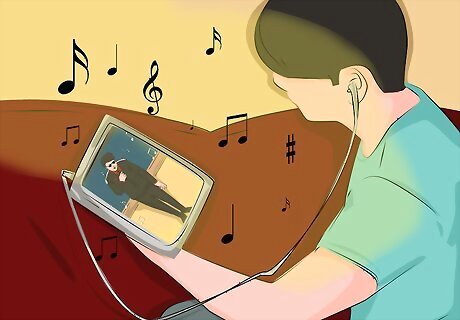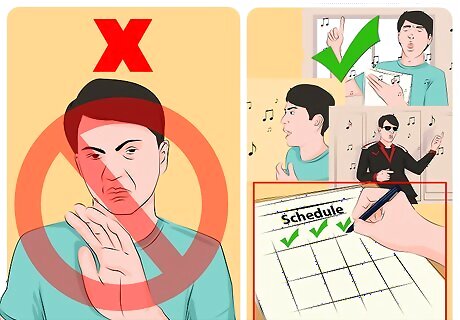
views
- Take the time to memorize the lyrics of your chosen song word-for-word, so you're not caught forgetting the words on stage.
- Practice in front of a mirror so you can test out your facial expression and dance moves.
- Let your personality shine when lip syncing—make the performance your own!
Planning A Routine

Choose a song you love. If you're in love with the material you're working with, that passion will shine through on stage. Choose a song that you're passionate about and that has personal meaning for you when lip syncing. Not only will you look happier performing if you love a song, you're less likely to slip up. If you really love a piece of music, you've probably listened to it over and over again. You're more likely to recall how to move your lips properly. Having a vested interest in what you're learning makes memorization easier. For example, even people who are bad with names can easily remember the names of people they find attractive. If you choose a song that interests you personally, you're more likely to retain information like lyrics and timing.

Memorize the lyrics. The first step to learning to lip sync is to memorize the lyrics you want to lip sync to. You can usually find lyrics online if you can't make out the precise words. Try singing along to the song a few times with the music playing before attempting to lip synch. Write out the lyrics over and over again. Actively pay attention to the words you're writing as you go. Memorization of material improves through writing. Write the lyrics 5 to 10 times, paying close attention to each word you're writing down on the page. Remember, oftentimes when lip syncing you may find it looks more authentic to sing the words quietly as you go along. Having the words committed to memory can really help you lip syncing go over well.

Use a mirror. Practice singing along to the song in front of a mirror. Watch how your lips move. See if they're in sync with the song. You may find that you need to slightly exaggerate the movements of your lips and mouth to make it look like you're singing. It can help to sing softly while the song is playing. Do not sing loud enough that your voice overpowers the recording. However, quietly singing the words can help your lip syncing look more accurate. In addition to remember the lyrics, timing is key. Try to keep track of musical interludes and how long they last. Try to count in your head to measure about when you'll need to start singing again. It might help to record yourself singing and then play it back. You can re-watch your performances and see where there's room for improvement.

Have fun with costume and dance moves. In addition to the singing itself, costumes and dance moves can add a lot to your musical routine. Not only do audiences enjoy people who are uninhibited on stage, a great costume and dance can prove a distraction if you do slip up lip syncing wise. Have fun and be creative. However, keep in mind your comfort is also key. If a certain dance move or costume makes you feel insecure, your audience will pick up on that. Only select outfits and dance moves that feel organic to your personality.

Let your personality show through. Lip syncing successfully is not all about successfully mimicking lyrics. Personality plays a big role in performance. Allow your unique personality to show through on stage. If you tend to be a comedic type, go for funny. Wear a goofy outfit. Use intentionally awkward dance moves. Pick a song that's lighthearted and fun. If you're a more reserved type, try choosing a more serious song. Try to convey your emotional connection by maintaining a reserved attitude during your performance.

Pick a specific person to focus on. If you're lip syncing in front of a crowd, pick a specific person and act as though you are lip syncing just to her. This can help make your performance more intense.
Mastering the Skill

Learn through watching. If you want to master a new skill, you need a guide. Oftentimes, the best way to learn a skill is by simply watching. Look up videos of lip syncing online or attend a lip syncing battle in your area. Pay attention all aspects of performance. Writers who want to be better writers read and pay attention to things like sentence structure, story, and dialogue. If you want to learn to lip sync, watch for performance persona, timing, and accuracy. If at all possible, ask questions. Questions about the nuances of performance can be a great way to learn more. If you're able to attend a lip sync contest, consider stopping a performer afterwards and asking him or her any questions you may have.

Practice consistently. There are no quick ways to master a new skill. You simply have to make time every day to practice and, with time, you will improve. Keep a consistent schedule. Practicing lip syncing should become as natural to you as brushing your teeth at night. Set aside a half or so to go over your chosen song a few times.

Understand your best learning style. There are different kinds of learners. Some people learn best by watching, reading, and studying. Others learn best by seeing and doing. In order to master lip syncing, understand and practice your personal learning style. There are many tests online you can use to gauge how you learn best.

Have patience. You progress is unlikely to be steady the entire time. When mastering a new skill, people usually make a lot of initial progress and then plateau. This often leads to frustration and people end up quitting. Have patience and be consistent. If you continue to practice each day, you will eventually surpass your plateau.




















Comments
0 comment